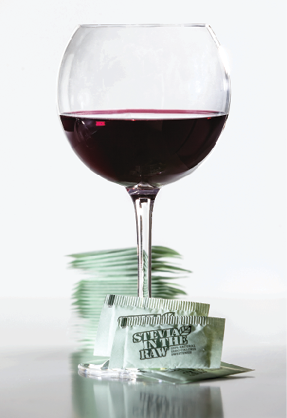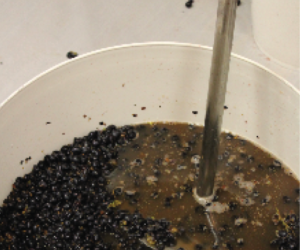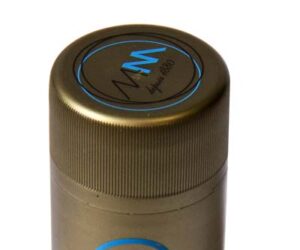Q
I grow and make Cabernet Sauvignon and Merlot in southwest Idaho. The season is intense but short. In order to reach decent ripeness (~25 °Brix), I have been growing with a very high leaf-to-cluster ratio. The wine is fairly good but has high pH values. I adjust the must with tartaric acid to an acceptable value (~3.7), but malolactic fermentation always drives it over 4.0. I’m not sure what causes the high pH — soil composition, leaf ratio, or a combination of both. To bring down the pH I have to add so much acid it unbalances the wine. If I add a little sweetener it does make it quite drinkable. Can I use Splenda or stevia at bottling or will that breakdown and ferment like sugar? Your thoughts will be greatly appreciated.
Daniel Page
Council, Idaho
A
I hear you on the high pH/high TA unbalanced wine issue. I myself have dealt with some vineyards and some wine lots where I have had to add so much tartaric to high pH musts just to keep the pH below 3.85 after malolactic is complete. The causes of this in the vineyard is worth its own article or articles as the sources are as complex as the methods for dealing with the resulting wines. High potassium in the musts can be a cause, (which needs to be addressed in the vineyard). Over cropping and a dense canopy can sometimes cause a high malate/high tartaric situation so that when the wine goes through malolactic fermentation (MLF), the resulting wine is unbalanced and in what I would certainly call a “microbial spoilage danger zone” with a pH higher than 3.80. At some point, all you can do is keep adding the tartaric to bring that pH down.
As you’ve found out, however, you risk getting some sharp off-flavors; also as you’ve found out, a little sweetness can really help mask or “round off” those flavors, resulting in a wine that tastes better balanced. If you add some kind of sweetener that is fermentable (table sugar, grape concentrate, maple syrup, honey, etc.) you risk an uncontrolled re-fermentation in the bottle, which is never fun. Hence your question about using stevia (a natural extract of a tropical leaf that is many times sweeter than sugar and is non-fermentable) or Splenda (sucralose, a non-fermentable artificial sweetener) is an interesting one.
Before we take the conversation further, please note that grape concentrate is the only “sweetener” approved in the US for commercial “for sale” grape table wine production. “At home” producers may use anything they feel like as long as they and their families will drink the results! I personally like to use things that are grown from the earth and don’t come from a lab, so stevia leaf extract, available in most grocery stores in powdered or liquid form, would be what I would choose to experiment with first. Try adding small amounts
of this to your wine and see if you like the results.
Adding stevia or Splenda is more than an issue of simply sweetness; we have to look at how these products react in wine, i.e. do they hydrolyze at wine pH, which would cause several issues, do they interact with other compounds to cause instabilities, do they interfere with gum arabic? To find these answers, bench trials are in order.
Start rough like “a pinch” or “a drop” (if the solution is liquid) and then two in 50 mL of wine to see what happens. Then as you figure out if it’s more or less than that, you may have to break out a gram scale (if you have one) for powdered stevia or create a liquid solution by dissolving a measured amount of powder in a measured amount of liquid (like a 10 g/100 mL solution). The idea is to find something you like on a small scale that you can then easily multiply and measure to apply to your whole batch, however big or small that batch might be.
Having used stevia myself in baking and cooking (I think the most neutral-tasting brand is “Stevia in the Raw”), my guess would be that you will see an increase in perceptible sweetness at around maybe 1⁄8 of a teaspoon per 50 mL, but I’m not sure the mouthfeel effects that you experience with sugar (an increase in roundness and viscosity) will happen with stevia. In fact, when I make fruit desserts like pies or cobbler with stevia, I frequently use half sugar and half stevia because the stevia just doesn’t cut through the fruit’s acidity the same way that sugar does.
In order to avoid using sugar, you might think about using a gum arabic product from one of the wine supply houses like AEB, Scott Labs or Laffort. Gum arabic can help create a sensation of viscosity and I could see it being nicely compatible with stevia for a sweetness-mouthfeel punch. Be sure to do bench trials on your wine with both additives so that you figure out your ideal addition rates before you add them to your larger batch. Stevia powder may take a little mixing so I would dissolve it very well into a smaller volume of your wine, put it through a strainer (because sometimes powder doesn’t dissolve well) before incorporating it into your larger wine batch.
Your idea to use a non-sugar additive is an intriguing one for the home winemaking community — let us know how it turns out!
Q
This may be a little off your usual subjects, but my question is about pomace. I understand it can be returned to the field. Can it be taken directly from the press and spread in the vineyard or does it need some sort of treatment first?
John Martin
Goodbee, Louisiana
A
Pomace, which is the skins, seeds and stems leftover from wine processing and pressing, can indeed be returned to the field as a soil amendment. You deposit it in a thin layer in the vine rows where it can act as effective mulch against weeds and help keep moisture in the soil. When it is tilled back in, the pomace provides additional organic material and nutrients to the vineyard. However, as you suggest, it’s not that simple. Spent grape skins and stems have to be composted and ideally mixed with other amendments before they are ready for use and may need quite a lot of help from you to become an ideal part of your viticultural regimen. Read on for more dirt (ahem) on how you can turn your winery waste to your advantage.
Using pomace for compost in the vineyard has many benefits. It can increase the number and variety of beneficial soil microbes, which better protects your vineyard from the ravages of pests and diseases. It increases the level of organic matter in the soil, adds to the soil nutrient profile (N-P-K-Ca is around 2.0-0.5-2.0-2.0), loosens heavy soils and improves drainage. Compost is typically applied at a rate of 1–5 tons per acre, typically in the summertime around June or July, which can return anywhere from 1⁄2 to 1⁄3 of the nutrients back to the soil.
As beneficial as compost from pomace can be, it’s important to not over-apply it as too much nitrogen can cause overly vigorous canopies, can increase the amount of hours needed to tend those big canopies and can increase susceptibility to rot and mold. Once compost is applied, its effects can be felt for 5–7 years afterwards so it’s important to go gradually and not to over-add. Figure that about three tons of grapes will yield around 1 ton of compost.
The most important thing to remember is that you really shouldn’t just dump pressed grapes or pressed, fermented must directly in the vineyard. Especially if you are using pressed white grapes, because doing so you risk attracting fruit flies and encouraging a high microbial population of undesirable organisms in the vineyard. You need to actually compost the pomace and turn it two or three times every week to keep it aerated (the aerobic breakdown is what helps develop the beneficial microbes). Like cooking meat, time and temperature are important. Keep your pomace at about 130–140 °F (54–60 °C) for at least a week (never let the temperature spike above 160 °F/71 °C) to kill pathogens. Keep moisture levels somewhat humid but never moist or wet, which will breed undesirable molds and can actually ferment and produce acetic acid. A typical compost windrow or pile, when managed well, will take about 6 months to “ripen,” which is why it’s typically applied in the summertime.
Pomace, which has a pretty high pH (not ideal for soils) also works best for your vineyard’s health if you can mix it with some other things before you compost it and apply it. Try a mixture of 50% composted grape pomace, 25% straw, 24% manure and 1% lime. The lime will help to lower the pH back to a more soil-friendly level. If you don’t have straw or manure, try working in yard clippings, turkey manure or even purchasing some of your community’s yard waste recycling compost. Just be sure that whatever you apply to the vineyard has been kept at 130-140 °F (54–60 °C) for at least one week to kill weed seeds and pathogens. Otherwise, you may not know what you may be introducing to your vineyards.
So to answer your question, yes, by all means re-use your winery’s pomace in your vineyards. It’s a wonderful way to also “complete the circle of life” from vineyard to winery and back again. Just remember that it’s not as simple as depositing your freshly pressed Chardonnay back into the vineyard. It takes a little work to make proper compost from pomace, but the rewards can be well worth it!
Q
I have a 59-gallon (223-L) batch of a 50% Cabernet Sauvignon, 50% old vine Zinfandel blend that is in oak. I pressed it in the fall with my stepdad. I used his family recipe, utilizing wild yeast from grapes to ferment it. Everything looks, smells, and tastes great with a delightful fruity nose, but it is only testing at 9% alcohol. His batch (same process) is at 15% alcohol. The only difference in the two wines is that mine was racked from glass to oak and placed in my cellar after two months. Fermentation seemed to slow a few days after. He wants me to add 100 proof vodka to stabilize it, but I would rather not turn it into a Port style. Will simply raising the temperature of wine restart fermentation, or do I need to pitch yeast? I really don’t want to lose all this beautiful wine. Please help.
Drew France
Middletown, Connecticut
A
Before you start going crazy with a fermentation restart protocol, are you sure that it is really stuck? The first thing that I would advise you to do is to taste and compare your wine with your stepdad’s. At 9%, and compared to 15%, you should notice sweetness on the palate.
If your wine tastes dry or similar to his, then it might be a measurement or instrumentation problem. I’d also suggest sending a sample to your nearest wine lab (I use ETS Labs based in St. Helena, California, and there are many others around the country) and get an alcohol measurement to make sure your 9% is a “real” number as well as to see what the residual sugar is, i.e. how far you’ll have to go if you do need to do a re-start. Unfortunately, human error and equipment variation can sometimes give us the wrong numbers.
Restarting a stuck fermentation is very difficult at this stage and takes a lot of time and some expense (more yeast, more nutrients, etc.) and somehow never quite makes the wine taste like it originally should have, (which is why the Wine Wiz always preaches “healthy fermentations first”). Similarly, I always make sure that the wine is really and truly stuck, by either running subsequent Brixes, “sugar pill” tests or sending samples to a lab if you can afford it, before attempting a restart. Sometimes a wine just gets cold and when the weather warms up the fermentation will complete itself. Other times, a fermentation just really slows down but will eventually finish. Unless the volatile acidity (VA) or other off-characters start to rear their ugly heads, it’s almost always better to let a fermentation complete itself naturally before making a huge fermentation restart attempt.
Likewise, I sometimes ask folks if they can’t live with a little residual sugar. If you’ve got 2-6 g/L (0.2-0.6%) residual sugar, and if you can sterile filter the wine (if you own a filter or can borrow or rent one), sometimes that extra sugar will just add a little body and mouthfeel, even if the wine isn’t textbook dry. However, if you have above 10 g/L, you’re really going to perceive the wine as sweet and it might be better to do as your stepfather suggests, and fortify the wine up above 17% by adding good quality brandy, perhaps adding additional sweetener, and turn the batch into an awesome Port-style wine.
I have a soft spot for Port-style beverages, having pioneered the “Bouteille Call” (yes, that’s what Randall Grahm decided to call it) Syrah and Raspberry sweet wine at Bonny Doon Vineyard back in the early 2000s. Lest you think these kinds of wine aren’t “serious” wines, let me submit that the higher alcohol and sugar generally make for longer aging and deeper complexity over time. Port-style wines are also perfect for so much more than just the dessert course. I love to use them in pan reductions for meat dishes, in creative cocktails (float a half-ounce over pink sparkling wine or use a teaspoon to pump up the cherry in your Manhattan), or as a perfect after dinner nut and cheese pairing. If you want to go sweet, just don’t drink your wine for dessert; make it a key part of the dish. Mix with plum or blueberry jam and reduce by 1⁄3 for a fabulous vanilla ice cream topper. Try a mixture of blackberry purée and sweet red wine in your ice cream freezer for a grown-up and very unique sorbet. As you can see, there are so many options for embracing a fortified red wine in your life and culinary repertoire.
If you just must restart this stuck fermentation, I suggest going on winemakermag.com and plugging “stuck fermentation” into the search box on the upper right hand corner. Many of us have weighed in on this topic over the years — I like James Henrie’s article from the Fall 1999 issue, available at www.winemakermag.com/story704.
Also, check out a nice wine industry reference at www.enartisvinquiry.com: Click on “Technical Information,” then “Winemaking,” then “Restart a Stuck or Sluggish Fermentation.” Their information is a very thorough step-by-step guide through what can be a long and involved process. Good luck!






